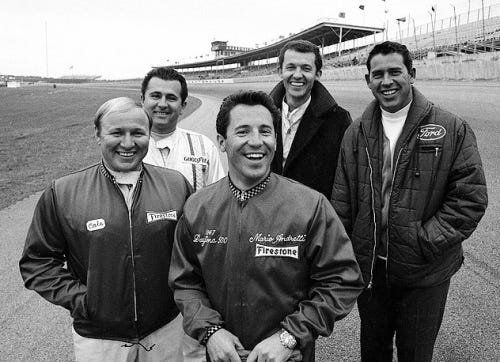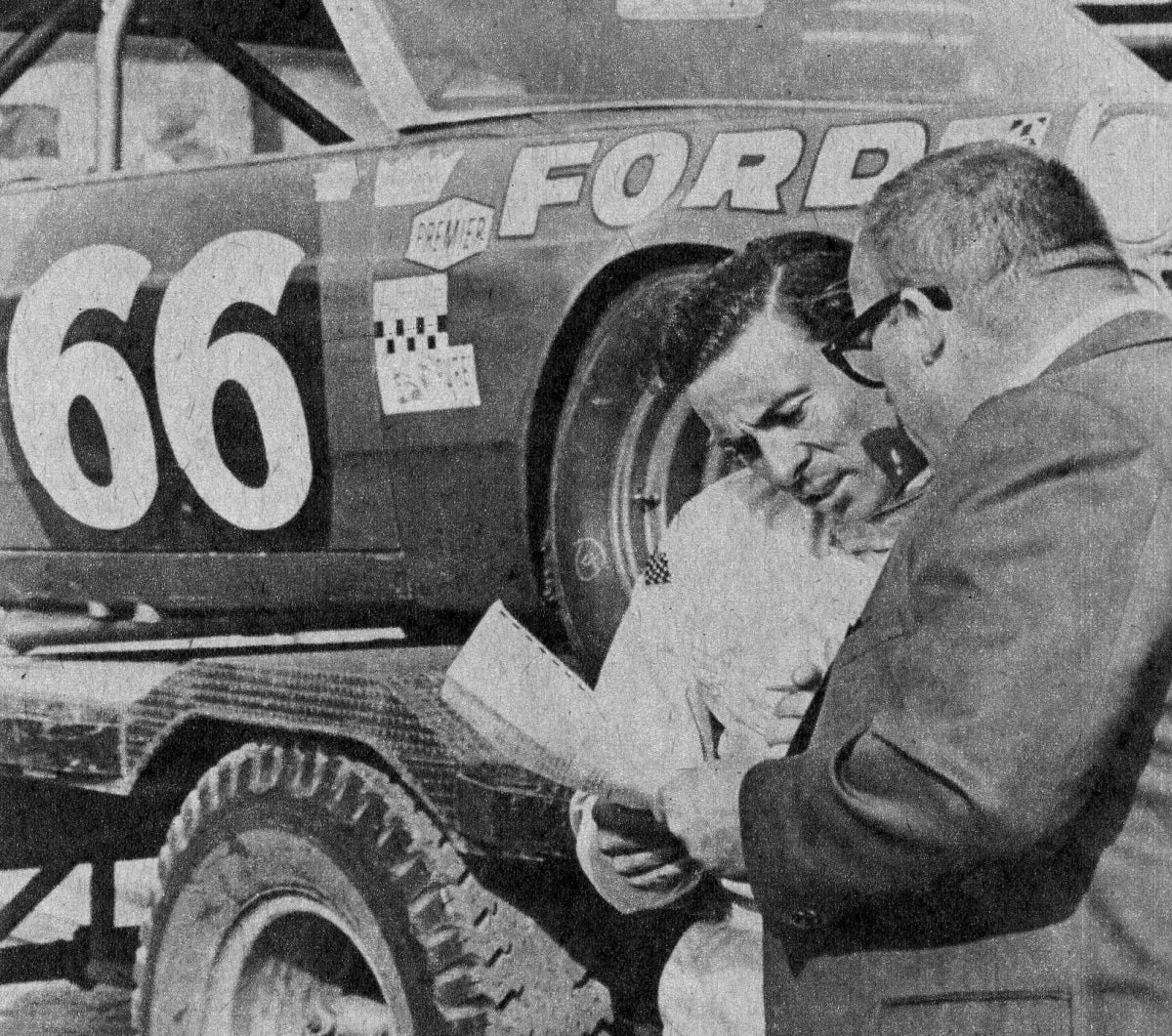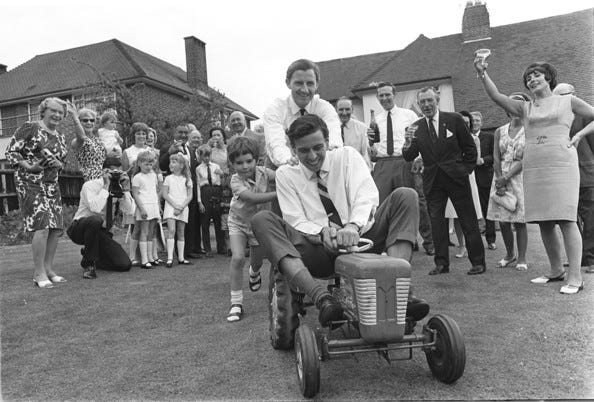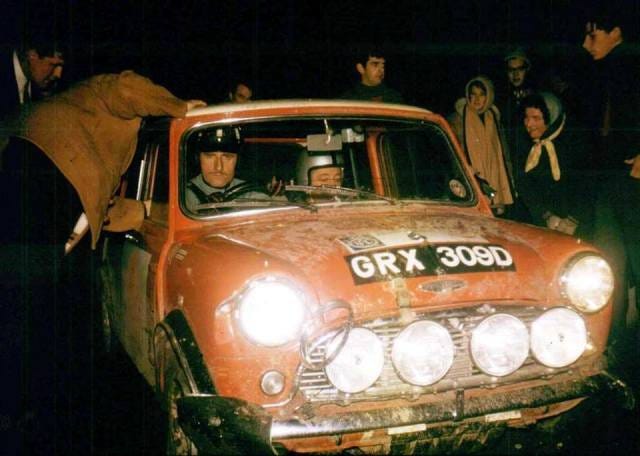JR Hildebrand (JRH) is a professional racing driver who’s competed in the last 12 consecutive Indianapolis 500s in addition to various other forms of motorsport during his career. He is also an adjunct lecturer for the REVS Program at Stanford University where he works with—and keeps a watchful eye over—his future autonomous competition. He previously contributed The Racing Safety Edition and The Virtual Racing Edition.
JR here. 2007 Formula One World Champion Kimi Räikkönen made his NASCAR Cup Series debut at Watkins Glen for Trackhouse Racing two weekends ago to enormous fanfare. It was a one-off race, facilitated by a new (and young) NASCAR team owner with a different view of creating value in the sport. If a Formula One champion getting behind the wheel of a stock car sounds unusual, that’s because it is. But it hasn’t always been.
Fifty years ago the world’s most elite racing drivers competed across multiple disciplines all at once, and while in their primes. Mario Andretti famously attempted to make his Formula One debut at the Italian Grand Prix in September of 1968 on the same weekend that he was racing in the Hoosier Hundred USAC dirt Champ Car race in Indianapolis by flying back and forth from Indy to Monza throughout the weekend. He topped the charts in Friday qualifying at Monza, flew back to finish second in the Hoosier Hundred to AJ Foyt on Saturday, and by the time he landed back in Italy (still seventh fastest after Saturday’s qualifying runs) he had been disqualified on account of Ferrari protesting that he had broken an obscure rule dictating that a driver must not have competed in another race within 24 hours of a grand prix.
Mario Andretti after winning Daytona with NASCAR greats (R-L) David Pearson, Richard Petty, LeeRoy and Cale Yarborough
No matter, he would officially make his F1 debut two months later at Watkins Glen by sticking his Lotus 49B on pole position, would go on to become a multiple-times USAC (now IndyCar) champion, a Daytona 500 winner, a Pikes Peak Hill Climb champion, an Indy 500 winner, an endurance sports-car racing legend, and eventually became the 1978 Formula One World Champion. Even during his F1 championship year he was racing all the 500-mile USAC oval races for Roger Penske, much to the chagrin of Lotus F1 team-owner Colin Chapman. But Mario wasn’t the only one. Over a 30-day span in 1967, Dan Gurney sat on the front row of the Indianapolis 500, won the Belgian Grand Prix Formula One race, and won the 24 Hours of Le Mans alongside AJ Foyt. Graham Hill is, to this day, the only driver to have ever won the Monaco Grand Prix, Indy 500, and 24 Hours of Le Mans, known as the Triple Crown, and could be found rallying a Mini Cooper or Ford Fairlane on Formula One off-weekends.
Why is this interesting?
It can be said, with the benefit of hindsight, that it was this behavior that elevated drivers like Mario Andretti, Dan Gurney, Graham Hill, Jim Clark, AJ Foyt, Jackie Stewart, Parnelli Jones, the Unsers, and a select group of other racers to an unprecedented level of recognition, value within the sport, and ultimate legacy. Some of these drivers are still household names today. All are considered among, if not the, greatest racing drivers of all time, even when compared to Senna, Schumacher, Hamilton, Petty, and Earnhardt, despite some of them having particularly short careers for one reason or another. So why did this stop happening, and could it start to happen again?
Jim Clark during his NASCAR debut
Much of this has to do with television. In the ‘50s, ‘60s, and ‘70s, the business of motorsport was somewhat primitive. Like any sport or entertainment platform it depended on creating audience and visibility, but in the absence of live broadcast television, a much greater percentage of the revenue attached to audience was generated locally around the events themselves. This dynamic created an environment where the value of individual events, even when a part of a broader championship like Formula One, USAC (now IndyCar), or NASCAR, was only tied to the value of those championships insomuch as it could help them manifest an attending audience, and where the overall notoriety and visibility of events was measured by their history, the magnitude of their challenge, the level of competition present, and the allure they created by the traditional media at large in the absence of instant viewership.
This environment was, in turn, ripe for elite drivers to rule. Great racers that could compete in the biggest events across various disciplines instead of just a single one became even greater, and it emboldened the elite of the elite to showcase a degree of grit, bravado, and skill that we’ve only seen in glimpses since. They epitomized the racer’s spirit, the feeling you get the first time you sit in a go-kart or a quarter midget and experience the chaos of taming the wild mechanical beast that, even as you grow, sees little difference in the appeal of a 200mph+ car at Indianapolis and a hot-rodded riding lawn-mower in the yard if there’s someone to beat. The business model of the sport supported it—because visibility within the sport was more closely connected to single great events as opposed to complete championships, drivers that could win throughout the sport became enormously valuable to stakeholders across the sport’s business spectrum.
Graham Hill and Jim Clark would drive anything
So TV should just add multipliers to this dynamic, right? Not exactly. Live broadcast television was a game changer for the overall visibility and value of motorsports across the globe because it enabled an enormous degree of audience growth, but it re-distributed value in a different way. Before TV, great single events held a strong percentage of value and that value was somewhat evenly distributed across disciplines; after the introduction of TV, value increased substantially but favored championship products that had the greatest potential for dependable, programmable prime-time viewing. This tightly bundled and aligned all the events within major championships together in TV rights packages, distinctly benefiting existing top-level products that fit this template like F1, USAC/IndyCar, and NASCAR. These properties saw enormous growth through the ‘80s and ‘90s on the back of ever-more widespread television viewership, helping them to establish the rights-fee based business models that they still operate by today.
Advertisers also flocked to these properties, directing their spending to the championships themselves and the teams that compete in them, because maximum visibility was now achieved by being associated with entities that got the most year-round viewership above all else. Forms of motorsport that didn’t fit this template due to any number of factors—extending outside a desired TV window, stage racing that goes on over a number of days, one-off events that aren’t part of a traditional championship structure, or events and championships that simply didn’t seem to be at the level of top-tier racing for a TV audience—didn’t see the same kind of relative growth, and in many cases became destabilized as businesses. Motorsport slowly went from a collection of loosely connected and more evenly valued parts to a stratified landscape of competing properties, and, as that happened, the power of influence swung away from drivers toward teams and sanctioning bodies.
We’re in the midst of another motorsport media revolution. Digital has allowed racing categories of all shapes and sizes to find their audience, tell stories in new ways, and raise the profile of drivers to levels they haven’t seen in at least thirty years. So will this new sea change bring us back the golden age of driver crossover? It’s my bet that it will. Racers, ultimately, are racers. And it’s that core spirit that drives the entire sport. Innovation matters, without question, but the true heartbeat of motorsport is our connection to the humanistic act at the center of it, and when drivers do things we’re not used to seeing them do, the humanness is just more clear to see. I spoke briefly with Trackhouse team owner Justin Marks after Kimi’s debut—I’m a huge fan of Justin’s and of Kimi’s so I was curious what his take on the experience was—and he was buoyant about where it could go. An amazing experience for the team to work with a driver of Kimi’s caliber from a different part of the sport, a sellout crowd on raceday, a 20% uptick in domestic viewership for that race and a yet unknown but speculated-to-be significant international audience for a sport that doesn’t yet tend to move the needle outside North America. This was just the first go-around, but when I imagine the potential of racers today doing this enough that we might eventually see the kind of achievements we saw from Mario, Jim, AJ, and Dan, I think the impact on attention and the sport in general might actually dwarf the effects that occurred back then.
Graham Hill rallying
When you talk to elite racing drivers behind the scenes you realize that each one is motivated by slightly different factors when it comes to trying something different. Some look at racing in a different discipline as a competitive challenge, a way to assert their ability and status no matter who against or what they’re in. Some consider their legacy, for when it’s all said and done. Some see the brand value. Some are just racers who are always curious about what else is out there and what it might be like. But it’s rare that they don’t have this itch in one form or another. So I’m excited to see how that underlying vibration manifests itself in the years to come, because I think it’s time that motorsport had some fresh human-centric energy. (JRH)
—
WITI x McKinsey:
An ongoing partnership where we highlight interesting McKinsey research, writing, and data.
How and where to work next. Selling, general, and administrative functions are integral to your organization’s success. What’s the best place for those people to work? Read here to see how the future of work will take shape.
—
Thanks for reading,
Noah (NRB) & Colin (CJN) & JR (JRH)
—
Why is this interesting? is a daily email from Noah Brier & Colin Nagy (and friends!) about interesting things. If you’ve enjoyed this edition, please consider forwarding it to a friend. If you’re reading it for the first time, consider subscribing (it’s free!).









Given the timing of this newsletter, I thought it was triggered by the news of Red Bull Racing / Alpha Tauri pursuing Colton Herta to move from IndyCar to F1. A missed opportunity you didn’t even mention as this is the perfect conclusion of why this is interesting and relevant. He would be the first US driver in F1 since Andretti, especially with F1 rising in popularity in the US. And introduces global F1 fans to IndyCar. Plus Andretti a racing pursuing their own constructor seat in F1 in the future.